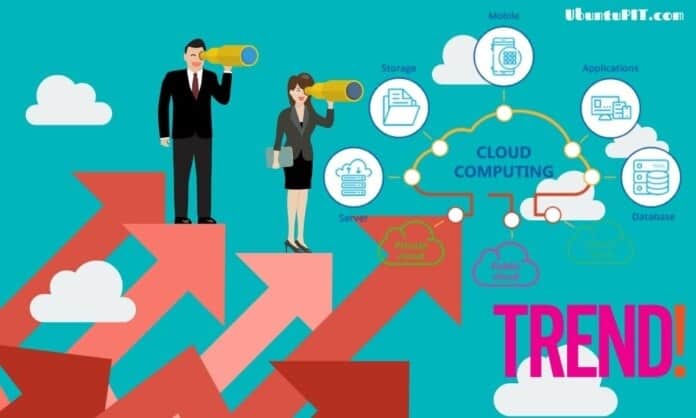You can consider cloud computing as the backbone of today’s data-driven industries and app-based tech ecosystem. It acts as a bridge between AI and Machine Learning. Besides, the modern cloud computing trends have facilitated other technologies to expand growth and offer consolidated solutions. Although there are many people who thought cloud computing would vanish just like many other technologies, it is a game-changer and ready to offer more excitement with long-lasting solutions.
As a result, with adopting cloud models and delivery of data, more businesses are going to transform into a cloud infrastructure to achieve reduced cost, rapid processes, and faster delivery. However, technology is expanding, and many changes are yet to come. To determine how the future of cloud computing will look like, we will discuss the best cloud computing practices of 2021 here in this article.
Top Cloud Computing Trends
Cloud Computing is developing so fast that we cannot predict what will happen, even tomorrow. Besides, the pandemic has shown us how it can plan a significant role in our daily life. As a result, large investors and big companies like Google, Microsoft, Amazon are focusing more on developing cloud-based software, platforms, and infrastructure.
Next, we will discuss the most important cloud computing trends you should monitor to remain ahead in the competition. So get ready to invest your time, and let’s try to determine how we will see cloud computing in the coming future.
1. Serverless Computing
Serverless computing has become a common phenomenon in the cloud computing trends of large companies. You can see it as an execution model in the cloud environment in which a cloud provider allocates dynamic resources for its customer.
It helps organizations reduce costs because they get charged only for the resources required to execute the functional piece of code. It acts as a combination of backend services. You can go up to any extent to meet requirements as the number of servers will not remain fixed.
Besides, Serverless Computing comes with many other advantages that you can enjoy, like increased observability, decomposing of your applications, event-based system, and so on. Therefore, it can contribute to enabling you to deploy faster with greater flexibility and speed up production. As a result, the architecture cost will be reduced eventually, and you can focus more on the UX.

2. FaaS Implementation in Cloud
FaaS or Function as a Service is one of the most important parts of cloud computing. It is related to microservices applications where we can write code to execute based on events without facing complex infrastructure problems.
So developers get a lot of help and can focus mainly on developing individual functions of their application. This runtime allows code to be executed only when required to minimize cost in the long run.
Optimum Cloud Computing practices are important to make crucial decisions and increase production speed. FaaS Implementation is certainly one of them that accelerates the development time. Besides, you will not need to take the hassle of managing servers for scalability.
As the user, you will be charged only when the resources are consumed. Therefore, it is a convenient choice for clients who are on a tight budget. Also, support for any programming language is there to increase the productivity of developers.
 3. The Edge
3. The Edge
There are many people who do not understand the Edge of cloud computing clearly. They think it refers to disappearing the cloud, although Edge computing brings the cloud closer to the source of data. It removes the necessity to depend on one of a dozen data centers for all the tasks. If you consider the faster response and increase capacity seriously, then the role of Edge computing is one of the cloud computing trends you might be interested in experiencing.
When talking about the positive effects of Edge Computing in a cloud environment, then prioritizing traffic will surely come fast on the list. It reduces the amount of data flowing from the primary network and can guide to gain lower latency.
As a result, the speed or performance will rise eventually for acquiring potential access to the products and information. However, we can also mention better security practices, uninterrupted connection, and better data management to highlight the importance of edge computing.

4. Hyper-scale Data Centers
Hyper-scale data centers are maintained and powered by industry-leading companies such as AWS, Microsoft, Google, and Apple. Their primary customers are enterprise scaled business organizations. As a result, you will need hyper-scale data centers, especially when it comes to having robust and scalable applications along with a storage portfolio of services.
It also increases the level of performance and ensures availability, one of the primary demands for the current competitive market. As people of today’s day and age, we can easily understand the importance of data centers. It is important to have proper data management and adequate storage as well.
Besides, recent research also states that hyper-scale data centers will expand at a CAGR of 26.32% between 2017-2022. Also, if you are wondering about how to reduce downtime losses and increase production speed, a hyper-scale data center is the solution you can look for.

5. Multi-Cloud and Joint Cloud Providers
The partnership helps with rapid go-to-market launches and the capitalization of mutual strengths for any business. Although it is still a new idea in cloud computing, you can already see real-life examples like the Oracle-Microsoft interconnect relationship.
It helps not only with more computable resources but also increases the storage to a great extent. As a result, it helps cloud providers deliver better services at a lower cost, and this practice will be one of the common cloud computing trends in the coming years.
Besides, Multi-Cloud comes with a handful of advantages for any cloud infrastructure. I want to start with security and privacy as multi-cloud renders 256-bit AES Encryption for data transferring. While multi-cloud can add flexibility to your work process, it can reduce the cost to ensure business continuity.
The joint partnerships between the large cloud providers will improve the performance and add more offerings. So more people are going to indulge themselves with the branches of cloud computing as well.
 6. Big Data, Cloud Computing, and IoT
6. Big Data, Cloud Computing, and IoT
Big Data, along with IoT, has enabled us to take full advantage of Cloud Computing in every aspect of life, such as home automation, security, agriculture, education, and so on. Besides, smart gadgets and software now come with smart sensors to let us enjoy the full power of cloud environments.
The combination of IoT, cloud computing, and Big data will surely produce many merged services, and we are going to experience interesting services in the future. It is important to analyze big data for extracting valuable resources. On the other hand, IoT can take care of legitimate interconnection between physical devices.
So any enterprise can enjoy the benefits of rapid production by converging up cloud computing with IoT and Big Data. It can enable them to achieve crucial information from their competitors and drive them to surpass the goals through accurate predictions and better business decisions.

7. Disaster Recovery Services
We cannot go without the services that help reduce downtime when talking about cloud computing trends. Even after all these years, downtime is the major downgrade of cloud infrastructure. It can cause you a lot of money.
As a digital company, you lose your reputation, especially if running an eCommerce sale may drop significantly. But, again, all companies have to follow the GDPR guidelines, which make this an obvious choice for the effective trends of cloud computing.
If you are a business owner, you must be concerned about your service to remain available as much as possible. Hence, Disaster Recovery Services can be your best friend to reduce the restore time to a lower RTO & RPO.
Besides, you can also enjoy the easy maintenance of your business operations and limit the losses to a certain extent. Therefore, these services will always be in great demand and become an integral part of cloud computing soon.

8. Automations and Optimizations
Automation is one of the most exciting things that Cloud Computing offers for any organization. Undoubtedly all the large cloud providers are focusing more on offering automation services for their customers. As a result, we are going to see automated cloud orchestration expanding its horizon in the coming days.
Optimization is another phenomenon that contributes to maintaining the quality and quantity of cloud services. So if you are a cloud enthusiast, try to track the ever-growing features and automation processes.
Scalability is another reason why we will experience a lot of cloud automation and optimization services. It helps to simplify processes, which is a crucial goal of any industry. Also, it can reduce the IT Infrastructure Costs and increase the system resiliency.
With the help of automation, you can also handle the failed server more effectively and limit the downtime loss. Therefore, automation and optimization will surely play an impeccable role in expanding cloud computing in the coming years.

9. Data Security
We can mention terms like Authentication and identity, access control, encryption, secure deletion, integrity checking to simplify data security in cloud computing. Data security is important to avoid misinterpretation and to remove faulty data that can make our life miserable.
From the beginning of cloud computing, security has been one of the primary cloud computing trends most people really care for. And surely, they are going to be more serious in the future to speed up the growth and reach the goal.
We can not express the importance of data security with words. In a cloud-based ecosystem, privacy and controlling authorization should be the main concern. Protection against DDoS is another thing we should take into account for having a safer cloud.
The new cloud security solutions offer high availability and support along with regulatory compliance. If you are a cloud professional or enthusiast, you must get your hands on the most important cloud computing applications for a smooth and safe journey in the cloud.

10. Hybrid Cloud Computing
We are going to end this list of cloud computing trends with the most hyped cloud computing practice. Currently, it is holding the spotlight, and you can expect it is not going to end soon. Hybrid computing is a mix-up of computing, storage, and services.
We can incorporate on-premises infrastructure, private cloud services, and a public cloud in a hybrid cloud. It is important for the digital business industry, especially for rapid transformation. We can also consider cost savings and increased revenue as well.
People are more interested in hybrid computing because of Lower capital expenditure, Scalability, and Reliability. Again in hybrid cloud, we get a separate place for handling critical workloads and less-sensitive workloads distinctly for better performance.
If you are looking to achieve flexibility for the future, hybrid computing is the solution you might look for. Big data processing becomes fun, and you will have access to public resources at a reasonable price.

Our Thought About The Trends
Cloud has become an integral part of our daily life. In the future, we are going to depend more on the cloud due to cloud adaptability and digital transformation. So following the most demanding cloud computing trends, we can try to predict the upcoming cloud services and get ourselves ready to face the consequences.
If you want to know more about the cloud practices, follow the large cloud providers like Google, AWS, Microsoft Azure, IBM, APPLE, and enlighten yourself with the modern cloud computing techniques.
I have already discussed the most important cloud computing practices that most people are familiar with. But I could not stop myself from mentioning cloud monitoring in this section. It is a combination of cloud coalitions, machine learning, and data fabrics.
As a key component of the cloud domain, the cloud monitoring industry is expected to see an annual rise of 22.7% between 2021 and 2026. It clearly shows how large companies are promoting monetizable insights to generate more revenue and establish this pursuit for the long run.
Finally, Insights
Last year was the year when the cloud computing industry saw the largest growth to facilitate remote work. In the most uncertain times, cloud technologies came up like a blessing to transform the traditional organizational processes.
Each company has concentrated on extending cloud capabilities and keep unlocking organizational growth. Besides, researchers have forecasted an 18.4% growth of the cloud industry by the end of this year. So we are moving towards a cloud-based world faster than ever.
You must understand the pros and cons of cloud computing to create an advantage for you. I believe this list of most exciting cloud computing trends will help you understand the existing cloud solutions and lead you on the right path for the future growth of your institutional career.

 3. The Edge
3. The Edge 6. Big Data, Cloud Computing, and IoT
6. Big Data, Cloud Computing, and IoT
